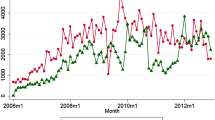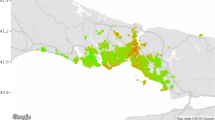Abstract
This study estimates a generalized spatial hedonic pricing model to assess how residential property values are impacted by inclusion within cluster developments and by proximity to various types of protected land. The estimated model simultaneously controls for the spatial dependence of residential housing prices and for the presence of spatial autocorrelation. The sample includes 4,008 single-family housing sales transactions within the non-urban portions of Larimer County in northern Colorado. The empirical framework accounts for topographical diversity across the study region, as well as distinguishing between several distinct types of publicly and privately protected land. The key findings of the study are: (i) proximity to national or state park land and to city or county open space has a significant positive impact on property values, while proximity to national forest land or to privately conserved land exhibits no significant effects; and, (ii) inclusion of a property within a cluster development decreases its value by 17 to 26 %. These findings are robust to different estimation techniques and model specifications, which suggests important considerations for policymakers who design development rules and alternative land protection measures aimed at preserving open space in non-urban areas.
Similar content being viewed by others
Notes
Although some studies report that protected open space might increase a local property tax base (e.g., Geoghegan et al. 2003), the evidence is inconclusive as to whether protected open space is capitalized into land values (e.g., Blakely 1991; Nickerson and Lynch 2001; Irwin and Bockstael 2001; Geoghegan 2002).
Geoghegan et al. (1997) report that increased landscape fragmentation may have a negative or positive effect on property values, depending on whether a property is located in an urban or rural area. Anderson and West (2006) find that properties with high population densities implicitly value proximity to parks by a factor of three.
The Growth Management Area (GMA) is the creation of an intergovernmental planning cooperation effort and is essentially an agreed band of county land that closely surrounds the cities and is likely headed for development and/or annexation.
The Denver-Boulder-Greeley, CO CPI is listed in semi-annual increments by the U.S. Bureau of Labor Statistics.
We narrowed down our list of parcel characteristics using a correlation coefficient, whereby we eliminated potential regressors with a correlation coefficient greater than 0.6 to reduce the risk of collinearity in the estimation.
Euclidean distance is but one type of distance measure with which one might attempt to capture the effects of open space protection on housing prices. An alternative measure might be that of driving distance that could potentially capture access benefits to open space.
Conceptually, such measures might capture access benefits to open space.
We attempt to capture the internalized effect on housing price from inclusion in a cluster development by using this dummy variable (DummyRCD/RLUP). Mentioned previously, the Euclidean distance measure (NGO/Trust/PrProtED) and the proximity dummy variable (DNGO/Trust/PrProt 0.5 km) are separately intended to control for the external effects of cluster development on housing prices.
It could be assumed that the n×1 vector of ones is included in one of the matrices of explanatory regressors.
References
Acharya G, Bennett LL (2001) Valuing open space and land-use patterns in urban watersheds. J Real Estate Financ Econ 22(2–3):221–237
Anderson ST, West SE (2006) Open space, residential property values, and spatial context. Reg Sci Urban Econ 36(6):773–789
Anselin L (1988) Spatial econometrics: methods and models. Kluwer, Dordrecht
Blakely M (1991) An economic analysis of the effects of development rights purchases on land values in King County, Washington. M.S. thesis, Washington State University
Bolitzer B, Netusil NR (2000) The impact of open spaces on property values in Portland, Oregon. J Environ Manag 59(3):185–193
Burchell RW, Downs A, McCann B, Mukherji S (2005) Sprawl costs: economic impacts of unchecked development. Island Press, Washington, DC
Cheshire P, Sheppard S (1989) British planning policy and access to housing: some empirical estimates. Urban Stud 26(5):469–485
Correll MR, Lillydahl JH, Singell LD (1978) The effects of greenbelts on residential property values: some findings on the political economy of open space. Land Econ 54(2):207–217
Ernst T, Wallace GN (2008) Characteristics, motivations, and management actions of landowners engaged in private land conservation in Larimer County Colorado. Nat Areas J 28(2):109–120
Geoghegan J (2002) The value of open spaces in residential land use. Land Use Policy 19(1):91–98
Geoghegan J, Wainger LA, Bockstael NE (1997) Spatial landscape indices in a hedonic framework: an ecological economics analysis using GIS. Ecol Econ 23(3):251–264
Geoghegan J, Lynch L, Bucholtz S (2003) Capitalization of open spaces into housing values and the residential property tax revenue impacts of agricultural easement programs. Agric Resour Econ Rev 32(1):33–45
Irwin EG (2002) The effects of open space on residential property values. Land Econ 78(4):465–480
Irwin EG, Bockstael NE (2001) The problem of identifying land use spillovers: measuring the effects of open space on residential property values. Am J Agric Econ 83(3):698–704
Kim CW, Phipps TT, Anselin L (2003) Measuring the benefits of air quality improvement: a spatial hedonic approach. J Environ Econ Manag 45(1):24–39
Kitchen JW, Hendon WS (1967) Land values adjacent to an urban neighborhood park. Land Econ 43(3):357–360
Kline JD (2006) Public demand for preserving local open space. Soc Nat Resour 19(7):645–659
Lee C-M, Linneman P (1998) Dynamics of the greenbelt amenity effect on the land market—the case of the Seoul’s greenbelt. Real Estate Econ 26(1):107–129
LeSage J, Pace RK (2009) Introduction to spatial econometrics. Chapman & Hall/CRC Press, Boca Raton
Lutzenhiser M, Netusil NR (2001) The effect of open spaces on a home’s sales price. Contemp Econ Pol 19(3):291–298
Nelson AC (1988) An empirical note on how regional urban containment policy influences an interaction between greenbelt and exurban land markets. J Am Plan Assoc 54(2):178–184
Neumayer E, Plümper T (2010) Making spatial analysis operational: Commands for generating spatial-effect variables in monadic and dyadic data. Stat J 10(4):585–605
Nickerson CG, Lynch L (2001) The effect of farmland preservation programs on farmland prices. Am J Agric Econ 83(2):341–351
Rosen S (1974) Hedonic prices and implicit markets: product differentiation in pure competition. J Polit Econ 82(1):34–55
Smith VK, Poulos C, Kim H (2002) Treating open space as an urban amenity. Resour Energy Econ 24(1–2):107–129
Taylor LO (2003) The hedonic method. In: Champ PA et al (eds) A primer on non-market valuation. Kluwer, Dordrecht, pp 331–393
Theobald DM, Hobbs NT (2002) A framework for evaluating land use planning alternatives: protecting biodiversity on private land. Conserv Ecol 6(1):5
Wallace GN, Theobald DM, Ernst T, King K (2008) Assessing the ecological and social benefits of private land conservation in Colorado. Conserv Biol 22(2):284–296
Weicher JC, Zerbst RH (1973) The externalities of neighborhood parks: an empirical investigation. Land Econ 49(1):99–105
Acknowledgments
This research was supported by USDA-CSREES contract 2003-35401-13801. The authors are indebted to George Wallace, Tawnya Ernst, and Sean Alley for their valuable assistance, and to Melissa Shelburne for assistance with the GIS programming/analysis. The authors also thank Robert Berrens, German Muchnik-Izon, and Ben Blau for helpful suggestions. The authors would like to acknowledge and thank Jim Payne and an anonymous referee for recommendations and constructive feedback during the peer-review process. Lastly, it should be noted that an earlier version of this manuscript was circulated under the title, “Hedonic Valuation of Land Protection Methods at the Rural-Urban Fringe: Implications for Cluster Development”.
Author information
Authors and Affiliations
Corresponding author
Appendix: Marginal price impact calculations
Appendix: Marginal price impact calculations
A complication arises in measuring the marginal impact of an open space variable in the spatial lag/autoregressive model (SAR) and in the generalized spatial model (SAC), given that the price vector is not specified explicitly in terms of the explanatory regressors in (2) and (4). As such, it is necessary to first present the models in explicit form. Following Kim et al. (2003), a series of algebraic rearrangements yields the marginal benefit (implicit price) of an arbitrary spatial variable,
where \(\mathbf {l}^{\prime }\) is a 1×n row vector of one spatial characteristic, I is n×n identity matrix, and \(r= \overline {1,2}\) in our setup. The Jacobian matrix in (3) implies that a price at one point in space is affected by a marginal change in one unique locational characteristic at that particular point and by the marginal changes of locational characteristics at all other points. To obtain the overall impact, we sum across the space such that \(\frac {\partial \mathbf {P} }{\partial \mathbf {l}_{l}^{\prime }}\mathbf {i}=\gamma _{l}[ \mathbf {I }-\rho \mathbf {W}_{r}]^{-1}\mathbf {i}\) reduces to \(\gamma _{l}\left ( \frac {1}{1-\rho }\right ) \mathbf {i}\), where i is a given column of the I matrix and where 1/(1−ρ) is a spatial multiplier (Kim et al. 2003).
Rights and permissions
About this article
Cite this article
Kling, R.W., Findley, T.S., Gahramanov, E. et al. Hedonic valuation of land protection methods: implications for cluster development. J Econ Finan 39, 782–806 (2015). https://doi.org/10.1007/s12197-014-9279-1
Published:
Issue Date:
DOI: https://doi.org/10.1007/s12197-014-9279-1




